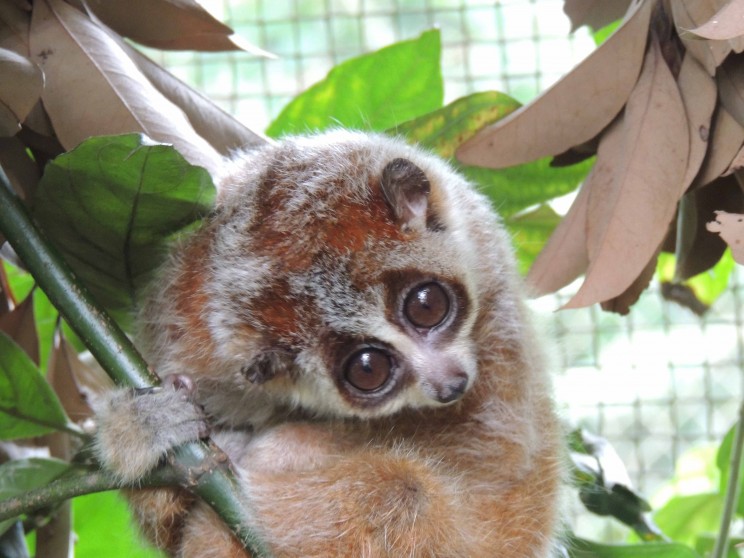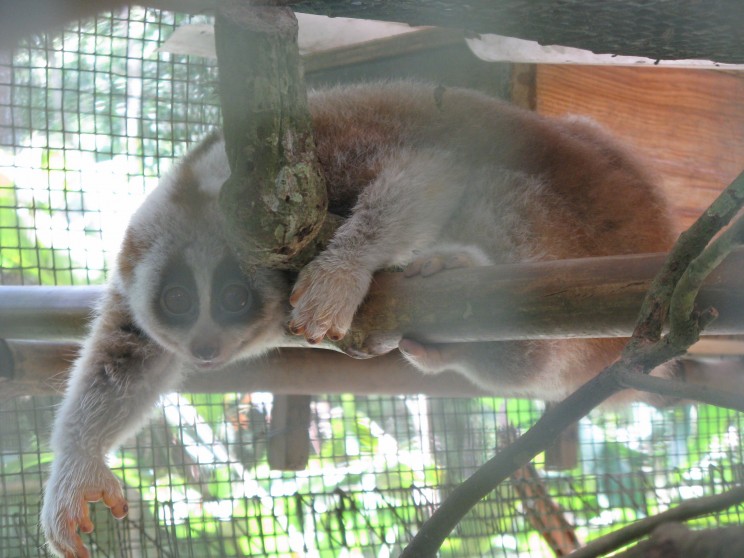Amid failures in saving numerous wildlife species worldwide, there is an encouraging success—decades of panda habitat degradation have been transformed into a remarkable recovery. The success is taking place in Wolong Nature Reserve of China—home to endangered giant pandas and more than 5,000 residents who share a 200,000-ha mountainous area. It is also occurring in many of the other 66 nature reserves and non-reserve areas across southwestern China.
The post Pandas and people: understanding their complex relationships for successful conservation appeared first on OUPblog.
By Mary Blair
Slow lorises are enigmatic nocturnal primates that are notoriously difficult to find in the wild. The five species of slow loris that have been evaluated by the International Union for the Conservation of Nature’s Red List of Threatened Species are classified as threatened or critically endangered with extinction. So, how did one end up recently on the set of Lady Gaga’s music video? Lorises don’t make good pets or video props, especially as they are the world’s only venomous primates. But, unfortunately, it is easier to see a loris as an exotic pet in a Youtube video or on Rihanna’s shoulder as a photo prop than it is to see them in the wild.
In my current research at the Center for Biodiversity and Conservation at the American Museum of Natural History, my team is surveying for Bengal (Nycticebus bengalensis) and pygmy slow lorises (N. pygmaeus) in Vietnam to determine their population status – how many lorises remain across different key sites in Vietnam, and how their current numbers compare to previous surveys. I have written before about the challenges my team has faced searching for these elusive creatures, but this time, I’d like to discuss the broader difficulties of searching for low-density, rare animals, and how knowledge gaps about these creatures can preclude the development of effective management plans for their conservation.

Intensive fieldwork on Vietnam’s primates only began in the mid-1990s, focusing on those species assessed to be the most in danger of extinction, especially gibbons (Nomascus spp.) and colobines such as snub-nosed monkeys (Rhinopithecus avunculus), doucs (Pygathrix spp.), and leaf monkeys (Trachypithecus spp.). Comparatively little research to date has focused on species assumed to be common such as the macaques (Macaca spp.) and the nocturnal lorises (Nycticebus spp.). These groups are presumed common because they seem to be able to persist in more diverse habitats including agroforest and regenerating forest, while gibbons, doucs, snub-nosed and leaf monkeys are found in established primary or secondary forests, which are rapidly depleting in Vietnam. As a result of this assumption, very few studies have focused on macaques or lorises in Vietnam and thus, there is very little if any information available to accurately assess their conservation status.
Now that researchers have started collecting data more intensively on slow lorises in Vietnam, we are finding that they are at such low densities that it is difficult to accurately calculate their density with statistical precision. However, as more and more researchers choose to focus on nocturnal, rare mammals like lorises across the globe (from owl monkeys to galagos to colugos), we can synthesize across our efforts to learn from each other, refine our methods, and generate more appropriate statistical models. In addition to continuing our surveys, we also working to raise awareness about threats to slow loris populations in Vietnam, and we are training local forest rangers and researchers to conduct ongoing population monitoring.

Ironically, in this case, there was the least information available about the animals assumed to be the most common. Without fundamental data on population status or distribution, it is difficult to either build effective conservation management plans for slow lorises or attract the federal and private funding necessary to implement such plans. And as such, major conservation actions in the region to date have focused on higher profile primate species, for which there is more information about conservation status. We are finally moving towards having enough scientific information to design a plan of action for improved conservation management of slow loris populations in Vietnam.
In Indonesia, at least 15,000 lorises are trafficked each year for the exotic pet trade. Numbers are not available for Vietnam or other countries in Mainland Southeast Asia, but our work so far suggests that pressure from the trade remains quite high. Our upcoming work in Vietnam, funded by the US National Science Foundation, will expand our research to include social science approaches to better inform policy makers about the underlying social and economic drivers of illicit trade in lorises. You can learn more about what other intrepid loris researchers are doing and how you can help to raise awareness and decrease demand for these endangered animals as exotic pets and photo props.
Dr. Mary Blair is the Assistant Director for Research and Strategic Planning at the Center for Biodiversity and Conservation at the American Museum of Natural History. Her research explores how knowledge of evolutionary processes can inform conservation planning. Her work in Vietnam is supported in part by the Disney Worldwide Conservation Fund and by a US National Science Foundation Science, Engineering, and Education for Sustainability Fellowship under Grant No. NSF-CHE-1313908. Mary has blogged about her work in Vietnam for the Museum’s Fieldwork Journal and for the New York Times, and is the author of Primate Ecology and Conservation. You can follow Mary on Twitter @marye_blair. Any opinions, findings, and conclusions or recommendations expressed in this material are those of the author and do not necessarily reflect the views of the U.S. National Science Foundation.
Subscribe to the OUPblog via email or RSS.
Subscribe to only earth and life sciences articles on the OUPblog via email or RSS.
Image credits: (1) A pygmy slow loris (Nycticebus pygmaeus) at the Endangered Primate Rescue Center in Cuc Phuong National Park, Vietnam. Photo by Dr. Mary Blair. Do not reproduce without permission. (2) A Bengal slow loris (Nycticebus bengalensis) at the Endangered Primate Rescue Center in Cuc Phuong National Park, Vietnam. Photo by Nolan Bett, used with permission.
The post Tracking down a slow loris appeared first on OUPblog.

 Anshumani Ruddra, illustrated by Gwangjo and Jung-a Park,
Anshumani Ruddra, illustrated by Gwangjo and Jung-a Park,
Dorje’s Stripes
Kane Miller, 2010/ 2011
Ages 5-9
A small Buddhist monastery nestled in the mighty Himalayas is surrounded by a vast forest. “Everything about the place spoke of quiet beauty,” reads the first page of Dorje’s Stripes. Perhaps the most quietly beautiful aspect of the monastery is its most unusual resident: a Royal Bengal Tiger named Dorje.
When Dorje arrived, Master Wu explains, he was weak and had not eaten for days. Upon regaining his strength under the monks’ care, Dorje began hunting for himself again, but every time he returned from the jungle, he had one less stripe. Eventually, he was left with nothing but two little dark spots above his eyes, but this evening Cheekoo, the youngest monk, notices that a new stripe has appeared on Dorje’s shoulders! What could it mean?
Master Wu tells the monks that he entered Dorje’s dreams shortly after his arrival and learned that the tiger’s clan was disappearing as a result of greedy hunters attacking tigers for sport and also hunting their prey. The mighty cats who escaped slaughter were left to starve. Every time one of his clan died, Dorje lost a stripe. Dorje’s new stripe fills the monks with great hope as Master Wu reveals that he and Dorje discovered a female tiger that morning as they walked in the forest.
A note that follows this story, beautifully illustrated in lush watercolors by the Korean team of Gwungjo and Jung-a Park, explains the plight of the Royal Bengal Tiger, India’s national animal. Less than 1,500 wild tigers live in the mangrove forests of the Sundarbans in Bengal today, having been hunted from a population of more than 40,000 at the beginning of the twentieth century. This powerful and majestic animal is now one of the Earth’s most threatened species, but the story of Dorje is one of hope. “Dorje only knew cruel men before he met us,” explains Master Wu, but just as the tiger – and perhaps eventually his clan – recovers under the monks’ care, so can future generations work to change the fate of this beautiful animal.
Abigail Sawyer
August 2011
This is an amazing book. If you love animals, I am sure that you'll appreciate these stories that Dr. Jane Goodall shares. Listen to an excerpt of the Hope For Animals and Their World: How Endangered Species Are Being Rescued from the Brink by Dr. Jane Goodall.

About the Book, courtesy of the publisher:
At a time when animal species are becoming extinct on every continent and we are confronted with bad news about the environment nearly every day, Jane Goodall, one of the world's most renowned scientists, brings us inspiring news about the future of the animal kingdom. With the insatiable curiosity and conversational prose that have made her a bestselling author, Goodall-along with Cincinnati Zoo Director Thane Maynard-shares fascinating survival stories about the American Crocodile, the California Condor, the Black-Footed Ferret, and more; all formerly endangered species and species once on the verge of extinction whose populations are now being regenerated.
Interweaving her own first-hand experiences in the field with the compelling research of premier scientists, Goodall illuminates the heroic efforts of dedicated environmentalists and the truly critical need to protect the habitats of these beloved species. At once a celebration of the animal kingdom and a passionate call to arms,
Hope For Animals And Their World: How Endangered Species Are Being Rescued from the Brink presents an uplifting, hopeful message for the future of animal-human coexistence.
About the Author, courtesy of the publisher:
Jane Goodall is the world's foremost authority on chimpanzees. An internationally renowned conservationist, she is the founder of the Jane Goodall Institute and has received many distinguished awards in science. Dr. Goodall is also the author of many acclaimed books, including the bestseller
Reason for Hope. Learn more on
Jane Goodall's website at http://janegoodallhopeforanimals.com/
Thane Maynard is the director of the Cincinnati Zoo.
CONTEST DETAILS
To enter, please visit Jane Goodall's website's What You Can Do Section and share something that you learned about a specific endangered animal.
Rules:
1. Please include your email address, so that I can contact you if you win. No email address, no entry.
2. For an extra entry, sign up to be a follower. If you're already a follower, let me know and you'll get the extra entry as well.
3. For another extra entry, subscribe via googlereader or blogger or by email and let me know that you do.
4. For another entry, blog about this giveaway and send me the link.
5. Leave a separate comment for each entry or you'll only be entered once.
The contest is limited to US and Canada only. No P.O. boxes. The contest ends at noon on November 27, 2009. Thank you so much, Anna and Hatchette Book Group for sponsoring this giveaway!





 Anshumani Ruddra
Anshumani Ruddra
Please count me in. Thanks for the chance. I learned that the Key Largo Woodrat is endangered.
lizzi0915 at aol dot com
+1 I follow
lizzi0915 at aol dot com
I was quite surprised at the number of endangered species from Jane Goodall's site. I learned that the Ivory-Billed Woodpecker is endangered and ways to help is to promote conservation of wetlands and protect cedar mulch. Thank you for this interesting giveaway.
chinook92(at)gmail(dot)com
I subscribe to your site via email.
chinook92(at)gmail(dot)com
I already follow your blog via Google Friends.
chinook92(at)gmail(dot)com
The Bald Eagles are endangered, and the website tells where you can best see them in flight.
bgcchs(at)yahoo(dot)com
Email subscriber.
bgcchs(at)yahoo(dot)com
I learned that there are opportunities for students to volunteer with the conservation efforts of the leatherback turtle through latinamericanseaturtles.org. I plan to conduct further investigations into this opportunity and make the information avaialable to both teachers and students who might wish to participate.
enyl(at)inbox(dot)com
I subscribe by e-mail.
enyl(at)inbox(dot)com